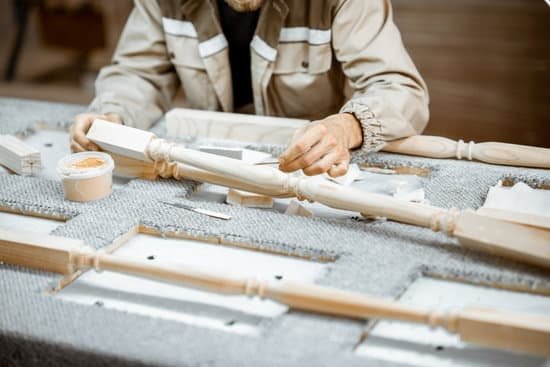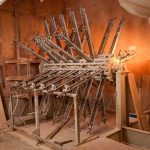Are you interested in learning a new skill and working with your hands? If so, you might want to consider exploring the world of woodworking.
In this article, we’ll provide a comprehensive guide on how to start learning woodworking, covering everything from understanding the basics and choosing the right type of wood, to finding classes or workshops in your area and utilizing online resources. Whether you are a complete beginner or simply looking to expand your knowledge, there is something for everyone in the art of woodworking.
Woodworking can be an incredibly satisfying and fulfilling hobby or even a potential career path for those who are passionate about creating with their hands. Understanding the basics of this craft is essential before diving into any projects.
This includes becoming familiar with various tools and equipment, as well as gaining insight into selecting the right type of wood for beginners. Safety should always come first when working with sharp tools and heavy machinery, so we will also cover some important tips for woodworking safety.
If you’re eager to get started but unsure where to begin, don’t worry – we’ve got you covered. We will discuss some beginner woodworking projects that are perfect for honing your skills, as well as learning the fundamentals of cutting, shaping, and joining wood. Additionally, if you prefer hands-on instruction, we will explore how to find woodworking classes or workshops in your local area.
And finally, for those who prefer independent learning, we’ll highlight some valuable online resources that can help you expand your knowledge and skills in the world of woodworking. So let’s get started on this exciting journey together.
Understanding the Basics
Woodworking is a craft that requires the use of various tools and equipment to bring your projects to life. Understanding the basics of these tools and how to use them is essential for anyone looking to start learning woodworking.
Essential Woodworking Tools
The first step in understanding woodworking tools and equipment is knowing the essential items you’ll need to get started. Some basic tools include a hammer, screwdrivers, hand saws, clamps, chisels, measuring tape, and a level. As you progress in your woodworking journey, you may also want to invest in power tools such as a circular saw, jigsaw, drill, and sander.
How to Use Woodworking Tools
Once you have the necessary tools, it’s important to learn how to use them safely and effectively. Taking the time to familiarize yourself with each tool and practicing proper techniques will help you gain confidence in your woodworking skills. There are plenty of online tutorials and instructional videos available that can guide beginners on how to use different woodworking tools.
Maintaining Woodworking Tools
Learning how to care for and maintain your woodworking tools is just as important as knowing how to use them. Regular cleaning, sharpening blades, and proper storage can prolong the lifespan of your tools and ensure they perform at their best when you need them. Additionally, keeping your workspace organized will make it easier for you to access the right tool for the job.
Understanding the basics of woodworking tools and equipment is a crucial first step for anyone looking to delve into this rewarding craft. Whether you’re interested in handcrafted furniture or simple DIY projects, having knowledge of essential tools and their usage will set you on the right path towards becoming a skilled woodworker.
Choosing the Right Type of Wood for Beginners
Woodworking is a versatile and rewarding hobby that allows individuals to create beautiful and functional pieces with their own hands. For beginners, one of the first crucial steps in learning woodworking is choosing the right type of wood. Different types of wood have unique properties that can significantly impact the ease of working with them and the final outcome of your project.
Understanding Wood Characteristics
Before starting any woodworking project, it’s essential to have a good understanding of the characteristics of different types of wood. Some woods are soft and easy to work with, making them ideal for beginners, while others are hard and more challenging to manipulate. Additionally, consider factors such as grain pattern, color, stability, and availability when choosing the right type of wood for your project.
Best Types of Wood for Beginners
For those just starting to learn woodworking, it’s recommended to begin with softer woods such as pine, cedar, or poplar. These woods are more forgiving and easier to cut and shape compared to harder varieties like oak or maple. Additionally, these softer woods are generally more affordable and readily available at most lumberyards or home improvement stores.
Where to Find Quality Wood
When getting started with woodworking, it’s important to source high-quality wood for your projects. Look for reputable lumberyards or suppliers in your area that offer a variety of wood species suitable for beginners. Many local woodworking clubs or workshops may also provide access to quality wood at discounted prices. It’s worth taking the time to find reliable sources for your wood as it will greatly influence the outcome of your projects.
Learning about different types of wood and their characteristics is an essential part of starting your journey in woodworking. By selecting the right type of wood for your skill level and project needs, you’ll set yourself up for success in creating beautiful pieces while honing your skills.
Safety First
Woodworking can be a rewarding and enjoyable hobby, but it is important to prioritize safety when working with wood and tools. Whether you are a beginner or an experienced woodworker, following some basic safety tips can help prevent accidents and injuries in the woodshop.
First and foremost, always wear the appropriate safety gear when woodworking. This includes safety goggles to protect your eyes from flying wood chips and sawdust, hearing protection to guard against loud machinery noise, and a dust mask to prevent inhalation of harmful particles. Additionally, it is important to wear fitted clothing that cannot get caught in power tools and closed-toe shoes for added protection.
Another essential aspect of woodworking safety is understanding how to properly use and maintain your tools. Make sure all equipment is in good working condition before use, and follow instructions carefully when operating power tools. It is also crucial to keep your workspace clean and free of clutter to avoid tripping hazards.
Furthermore, always be mindful of where your hands are at all times, especially when using sharp cutting tools or power saws. Take the time to familiarize yourself with proper cutting techniques and always use push sticks or other safety devices when necessary. By respecting the power of the tools you are using and staying focused on the task at hand, you can reduce the risk of accidents while woodworking.
Learning how to start learning woodworking involves not only acquiring the necessary skills but also understanding the importance of prioritizing safety in every aspect of your work. By following these tips for woodworking safety, beginners can create a safe environment for themselves while honing their craft and undertaking exciting projects.
Beginner Woodworking Projects to Start With
Woodworking is a versatile and rewarding hobby that allows individuals to create functional and decorative items from wood. For beginners looking to start learning woodworking, it can be daunting to know where to begin. One of the best ways to get started with woodworking is by trying out some beginner projects. These projects are typically simple, require only basic tools, and are a great way to develop foundational skills.
One of the most popular beginner woodworking projects is building a simple wooden shelf. This project introduces beginners to essential woodworking techniques such as measuring, cutting, and sanding. Building a shelf also provides an opportunity for beginners to practice using basic tools like a saw, drill, and sander. With just a few pieces of lumber and some screws or nails, beginners can create a practical and attractive shelf for their home.
Another great beginner woodworking project is crafting a basic wooden picture frame. This project helps beginners learn about the importance of precision in woodworking as they measure and cut the wood to create the perfect frame for their favorite photos or artwork. Additionally, assembling the frame requires mastering basic joinery techniques such as mitered corners or simple butt joints. Beginners can personalize their frames by adding decorative details such as beveled edges or routed designs.
For those interested in learning woodworking, starting with these beginner projects will provide valuable hands-on experience that will lay the foundation for more advanced woodworking skills. As beginners gain confidence through completing these projects, they can gradually move on to more challenging creations while expanding their knowledge of different tools and techniques used in woodworking.
Learning the Fundamentals
When starting to learn woodworking, it is essential to grasp the fundamentals of cutting, shaping, and joining wood. These skills are the building blocks for more advanced woodworking projects and will form the foundation of your abilities as a woodworker.
Here are some essential skills you need to master when learning woodworking:
- Understanding different types of cuts: Whether it’s crosscuts, rip cuts, or beveled cuts, knowing how to make precise and accurate cuts is crucial in woodworking.
- Shaping wood with hand tools: Learning how to use hand planes, chisels, and rasps to shape wood is an important skill that will enable you to create smooth and even surfaces on your projects.
- Joinery techniques: Understanding the various methods of joining wood together, such as dovetail joints, mortise and tenon joints, and pocket hole joinery, will allow you to create strong and durable connections in your woodworking projects.
One way to start learning these fundamentals is by taking a beginner’s woodworking class or workshop. In these settings, experienced instructors can guide you through the process of mastering basic woodworking skills.
Additionally, online resources such as instructional videos and tutorials can also provide valuable insight into cutting, shaping, and joining wood. Remember that practice makes perfect when it comes to woodworking, so don’t be afraid to take on simple projects that allow you to hone these fundamental skills.
Finding Woodworking Classes or Workshops in Your Area
Woodworking classes or workshops can be an excellent way to kickstart your journey into the world of woodworking. These classes provide hands-on experience, expert guidance, and a supportive community of fellow enthusiasts. If you’re wondering how to start learning woodworking, finding a class or workshop in your area is a great first step.
One of the best ways to find woodworking classes or workshops in your area is by checking with local community colleges, vocational schools, or adult education centers. Many of these institutions offer woodworking courses for beginners, as well as more advanced classes for those looking to refine their skills.
Another option for finding woodworking classes is to reach out to local woodworking clubs or associations. These groups often have resources and information about upcoming workshops or classes in the area. Additionally, attending club meetings can help you connect with experienced woodworkers who may be able to point you in the right direction.
If you prefer a more personalized approach, you can also look for individual woodworkers or artisans in your area who offer one-on-one instruction. This can be a valuable opportunity to learn from someone with extensive experience and receive tailored guidance on your woodworking journey. Websites and social media platforms are great places to search for these independent instructors.
| Finding Woodworking Classes | Benefits |
|---|---|
| Community colleges, vocational schools, adult education centers | Expert guidance, hands-on experience |
| Local woodworking clubs or associations | Information about upcoming workshops and classes |
| Individual woodworkers/artisan instructors | Tailored guidance and personalized instruction |
Online Resources for Learning Woodworking
So, you’ve decided to start learning woodworking. Whether as a hobby or a new skill to hone, woodworking can be an incredibly gratifying and rewarding craft. If you’re looking for resources to help you on your journey, there are numerous online platforms and websites that offer valuable information, tutorials, and guidance for beginners. Here are some of the best online resources for learning woodworking:
- The Wood Whisperer – This website offers a wide range of instructional videos, articles, and product reviews geared towards woodworkers of all levels.
- Fine Woodworking – Known for its high-quality content, Fine Woodworking provides in-depth tutorials, project plans, and tips from expert woodworkers.
- WOOD Magazine – The official website of WOOD Magazine provides a wealth of resources including project plans, technique tutorials, tool recommendations, and more.
In addition to these websites, social media platforms like YouTube and Instagram have countless woodworking channels and accounts that offer free video tutorials, project ideas, and inspiration. Many professional woodworkers share their knowledge and expertise through these channels and engaging with their content can be an excellent way to learn new techniques.
Remember that while online resources are incredibly helpful, nothing beats hands-on practice. Look for opportunities to apply what you learn in real-life projects and don’t be afraid to make mistakes – they’re all part of the learning process. With the right combination of online guidance and practical application, you’ll be well on your way to mastering the art of woodworking in no time.
Conclusion
In conclusion, learning woodworking can be a fulfilling and enjoyable journey for anyone interested in creating beautiful and functional pieces from wood. Whether you are just starting out or have some experience, the key is to build a strong foundation of knowledge and skills. Understanding the basics of woodworking tools and equipment, choosing the right type of wood for your projects, and prioritizing safety are essential steps in the learning process.
After grasping the fundamentals, beginners can start with simple woodworking projects to practice their skills and gain confidence. Learning how to cut, shape, and join wood is crucial in creating well-crafted pieces. Finding woodworking classes or workshops in your area can provide valuable hands-on experience and guidance from experienced woodworkers. Additionally, there are plenty of online resources available for those who prefer self-paced learning or want to supplement their knowledge.
As you embark on your woodworking journey, remember that patience and perseverance are key. Don’t be afraid to make mistakes – they are part of the learning process. Keep practicing and experimenting with different techniques to improve your skills. Whether you choose to pursue woodworking as a hobby or a potential career path, the possibilities are endless. So take the first step today by exploring how to start learning woodworking, and enjoy the rewarding experience of working with wood.
Frequently Asked Questions
Can I Teach Myself Woodworking?
Yes, it is possible to teach yourself woodworking. With the abundance of online resources, tutorials, books, and videos available, you can learn the basics of woodworking and gradually improve your skills through practice and dedication. It’s important to start with simple projects and gradually move on to more complex ones as you gain confidence in your abilities.
How Do I Start Woodworking With No Experience?
Starting woodworking with no experience can seem daunting, but it’s actually quite achievable with the right approach. Begin by familiarizing yourself with the basic tools and their uses.
Then, start with straightforward projects that don’t require advanced techniques or expensive materials. Practice foundational skills such as measuring, cutting, sanding, and assembling to build a solid understanding of woodworking fundamentals.
What Do I Need as a Beginner Woodworker?
As a beginner woodworker, there are several essential tools and supplies that you’ll need to get started. A few key items include a workbench, a saw (such as a circular saw or miter saw), a drill/driver, measuring tools (like a tape measure and combination square), sandpaper or a sander for smoothing surfaces, safety gear (safety glasses, ear protection, dust mask), clamps for securing workpieces, and a few basic hand tools like chisels and a hammer.
It’s important not to go overboard with buying tools at first; begin with the essentials and gradually expand your collection as needed for specific projects.

Hi everyone! I’m a woodworker and blogger, and this is my woodworking blog. In my blog, I share tips and tricks for woodworkers of all skill levels, as well as project ideas that you can try yourself.





